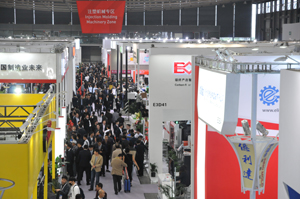CHINAPLAS
Visitor numbers at day one exceed 40,000 / Foreign share reaches about 25% / Mega-fair belies impressions of economic slowdown
 The exhibition halls at "Chinaplas" were swarming with visitors (Photo: PIE) |
The rain might have left a few jackets damp, but it certainly did not dampen the mood on the opening day of this year’s “Chinaplas” (www.chinaplasonline.com). Exhibition halls were brimming, and the official statistics released by show organiser Adsale (Hong Kong / China; www.adsale.com.hk) indicate that 40,264 visitors came to the Shanghai fairgrounds on day one. About one fourth of them – 10,664 to be exact – came from countries outside China. If the interest in the event remains as high, the organiser’s predictions for a total of 140,000 visitors could even be exceeded.
While there has been a lot of talk of late about the perceived slowdown in the Chinese economy, the mood among both visitors and exhibitors effectively put an end to such assumptions. Adsale chairman Stanley Chu confirmed that impression to Plasteurope.com, pointing to his talks with exhibitors on the first day of the show. While it may be the case that other sectors of the Chinese economy may be slowing, that cannot be said of plastics. Nothing illustrated this better than the fact that the open space between the fairground halls has been filled with an impressive number of outdoor tents, housing additional exhibits, including blow-moulding machines.
PIE took a closer look at the recycling zone making its debut this year. An impressive number of local machinery producers set up shop here, offering anything from shredders and laser sorting technology machinery to full-scale sorting and regrinding lines – a lot of them made in China. There is no denying that interest in recycling is rising and that local players are ready to cater to this increase in demand. Speaking to the show’s daily newspaper, Ning Hong Tao, president of the Plastics Recycling Committee of China, part of the Plastics Processing Industry Association, said the most important future development will be that of automatic segregation machinery for mixed plastic waste. This, he added, will come to replace the more traditional methods, which are either based on manual sorting or on chemical separation.
In a repeat of last year’s exhibition in Guangzhou, the fair officially kicked off with the “Design and Innovation” event, which includes a series of lectures and presentations organised in collaboration with chemicals giant BASF (Ludwigshafen / Germany; www.basf.com). The “Medical Plastics Conference”, co-organised by PIE, drew a huge audience, too. The day of countless handshakes, networking sessions, conferences, seminars and press events drew to a celebratory close with the opening banquet and an entertainment programme for VIP visitors that featured artists and displays paying homage to the show’s 30th anniversary.
While there has been a lot of talk of late about the perceived slowdown in the Chinese economy, the mood among both visitors and exhibitors effectively put an end to such assumptions. Adsale chairman Stanley Chu confirmed that impression to Plasteurope.com, pointing to his talks with exhibitors on the first day of the show. While it may be the case that other sectors of the Chinese economy may be slowing, that cannot be said of plastics. Nothing illustrated this better than the fact that the open space between the fairground halls has been filled with an impressive number of outdoor tents, housing additional exhibits, including blow-moulding machines.
PIE took a closer look at the recycling zone making its debut this year. An impressive number of local machinery producers set up shop here, offering anything from shredders and laser sorting technology machinery to full-scale sorting and regrinding lines – a lot of them made in China. There is no denying that interest in recycling is rising and that local players are ready to cater to this increase in demand. Speaking to the show’s daily newspaper, Ning Hong Tao, president of the Plastics Recycling Committee of China, part of the Plastics Processing Industry Association, said the most important future development will be that of automatic segregation machinery for mixed plastic waste. This, he added, will come to replace the more traditional methods, which are either based on manual sorting or on chemical separation.
In a repeat of last year’s exhibition in Guangzhou, the fair officially kicked off with the “Design and Innovation” event, which includes a series of lectures and presentations organised in collaboration with chemicals giant BASF (Ludwigshafen / Germany; www.basf.com). The “Medical Plastics Conference”, co-organised by PIE, drew a huge audience, too. The day of countless handshakes, networking sessions, conferences, seminars and press events drew to a celebratory close with the opening banquet and an entertainment programme for VIP visitors that featured artists and displays paying homage to the show’s 30th anniversary.
27.04.2016 Plasteurope.com [233972-0]
Published on 27.04.2016

 German version of this article...
German version of this article...